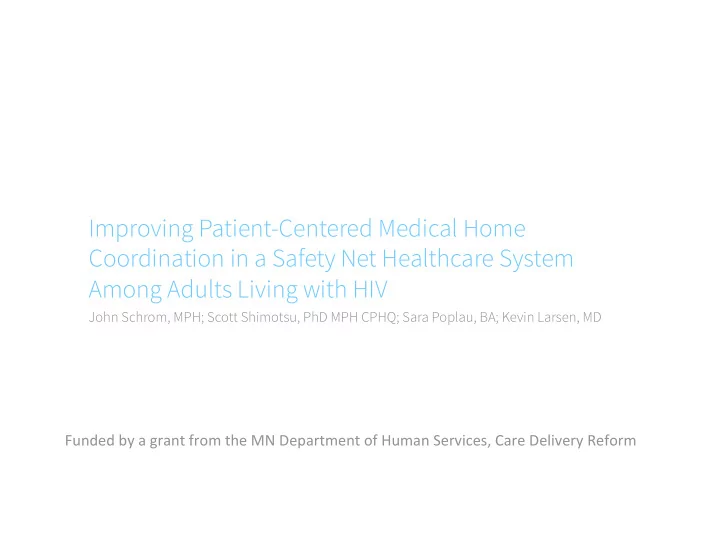

Improving Patient-Centered Medical Home Coordination in a Safety Net Healthcare System Among Adults Living with HIV John Schrom, MPH; Scott Shimotsu, PhD MPH CPHQ; Sara Poplau, BA; Kevin Larsen, MD Funded ¡by ¡a ¡grant ¡from ¡the ¡MN ¡Department ¡of ¡Human ¡Services, ¡Care ¡Delivery ¡Reform ¡
I HAVE NO DISCLOSURES This study has been approved by the Hennepin County Medical Center IRB: 11-3306
Positive Care Center • Part of Hennepin County Medical Center • Serves >1600 Patients in >8000 encounters • Funded by Ryan White Outpatient Medical Services • Case Management • Health Education/Risk Reduction • Benefits Counseling • Transportation Services • Chemical Dependency • • Certified Minnesota Health Care Home
Patient-Centered Medical Home • AKA Health Care Homes • Passed in 2008 • Certifies clinics that meet criteria: Patient- and Family- Friendly • Quality Improvement Teams • Learning Collaborations • Aligned Financial Incentives • Outcomes-Based Recertification •
PCMH Payment Methodology
PCMH Payment Methodology Syst Systems ems Tier Tier Minut Minutes es Payment ayment 0 0 0 $0 1-3 1 15 $10.14 4-6 2 30 $20.27 7-9 3 45 $40.54 10+ 4 60 $60.81
Medical Tier Versus Actual Coordination Time
HOW CAN WE BETTER UNDERSTAND CARE COORDINATION REQUIREMENTS OF PEOPLE LIVING WITH HIV?
Methods • Collected data from 2008 – 2011: Medical data (HIV VL, Weight Loss, Complexity Tier) • Social data (Housing, Employment, Income, Literacy, Interpreter Needs) • Case Management utilization (Activity, Minutes) • • Statistical Analysis: Linear regression • Students t-test •
Results Rac ace/Ethnicity e/Ethnicity White 20.7% • 610 patients Black 61.0% • Average: 141 min/mo • Range: 2 – 910 min/mo Hispanic 5.3% Ag Age e AI 2.6% 18-34 19.7% Asian 1.1% 35-44 28.2% Gender Gender Multi 1.6% Male 69.0% 45-54 36.5% Other 5.1% Female 31.0% 55+ 15.5% Unk 2.5%
Results Tier ¡0 ¡ MI/CD ¡ 1% ¡ 8% ¡ Other ¡ 18% ¡ Tier ¡1 ¡ 27% ¡ Unk ¡40% ¡ Housing ¡ Medical ¡ 18% ¡ 41% ¡ Tier ¡2 ¡ 25% ¡ Ins ¡15% ¡ Tier ¡4 ¡ 1% ¡ Tier ¡3 ¡ 6% ¡ Care Coordination Activity Medical Complexity Tier
Results – Linear Model Patients atients Estimat Estimate e Unemployed or Disabled 83.5% 35.78** In Poverty 84.3% 20.81 Uncontrolled Weight Loss 4.6% 23.04 Requires Interpreter 9.9% 59.50*** >= 100 Miles From Clinic 2.4% -40.14 *p < 0.05; **p < 0.01; ***p < 0.0001
Results – Linear Model Patients atients Estimat Estimate e Literacy – Learning Disabled 6.5% 5.32 Literacy – Not 6.6% 43.27* Housing Status – With Friend 23.4% 19.21 Housing Status – Homeless 19.0% 6.29 Housing Status – Institutional 10.2% 75.51*** *p < 0.05; **p < 0.01; ***p < 0.0001
Results – Linear Model Par arame ameter Estimat er Estimate e Medical Complexity Tier 12.59* *p < 0.05; **p < 0.01; ***p < 0.0001
Summary of Findings • Current payment methodology has limited correlation with actual care coordination utilization. • Social Conditions have larger impact than Medical Conditions: Institutionally Housed • Requiring Interpreter • Unemployed • Literacy •
Limitations and Further Study • Limited to HIV population Already receiving services through Ryan White • • Use of billing data • Variable quality of social data
Thank You! • Scott Shimotsu • Sara Poplau • Kevin Larsen • Molly Jacques • Rob Krieger • Rachel Tschida • Muree Larson-Bright • PCC Sta ff
Recommend
More recommend